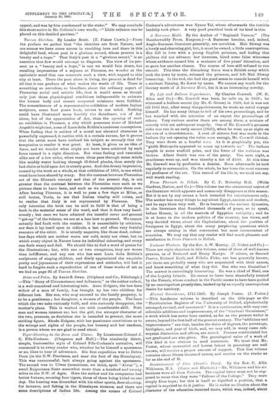Tuscan Sketches. By Leader Scott. (T. Fisher Unwin.)—From the preface
we gather that "the sketches are from Nature, and are scenes we have come across in rambling here and there in this delightful land, whose past is a glorious record, whose present is a beauty and a hope." That Italy's past is a "glorious record," is an assertion that few would attempt to disprove. The view of its pre- sent as a "beauty and a hope," is one we would fain share, but recalling impressions of a sojourn at Florence, we wonder at the optimistic mind that can entertain such a view, with regard to this city at least. There the past alone is living, the present is dead for all that it can produce of what makes the worth of life. There is something so nerveless, so bloodless, about the ordinary aspect of Florentine social and artistic life, that it would seem as though only just those physiological conditions indispensable to animate the human body and ensure corporeal existence were fulfilled. The remembrance of a representative exhibition of modern Italian sculpture, some four years back, recurs to our mind. Nothing could have illustrated more forcibly the decadence, not of Art alone, but of the appreciation of Art, than the opening of such an exhibition in Florence, a city which possesses some of Michael Angelo's mightiest, some of Luca della Robbia's tenderest conceptions. When feeling that is neither of a moral nor elevated character is powerfully expressed, it carries with it a certain excuse, fpr it proves that the artist must have realised his subject so strongly that the temptation to render it was great. At least, it gives us an idea of force, and we wonder what might not have been achieved by such force turned in a right direction. But when feeling and execution alike are of a low order, when mean ideas pass through mean minds like muddy water leaking through ill-fitted planks, then surely the last claim or hold upon Art is utterly gone. And this dreary impression, caused by the work as a whole, at that exhibition of 1883, is one which must have been shared by many. But the contrast between Florentine art of the fifteenth century and that of the present day, is not greater than the contrast between the Florentine race such as we picture them to have been, and such as we contemplate them now. After leaving Florence, it is well to pass a few days at Milan, or still better, Tarin, to see that Italian vitality still exists, and to realise that Italy is not represented by Florence. The only intention the book can be said to fulfil is that of being a book in the material sense of the word, and that it does very hand- somely ; but once we have admired the tasteful cover and general "get-up" of the volume, we are at a loss how to proceed. We cannot actually find fault with the matter. It is unassailable by criticism, nor does it lay itself open to ridicule, a last and often very fruitful resource of the critic. It is utterly negative, like those dead, colour- less days which are neither warm nor cold, misty nor clear, but on which every object in Nature loses its individual colouring, and every one feels weary and dull. We should like to find a word of praise for the illustrations ; but, with one or two exceptions, they are worse than indifferent, and any one who has seen Luca della Robbia's sculptures of singing children, and dimly appreciated the exquisite purity and joyousness of their expressions and attitudes, will find it hard to forgive each a reproduction of one of these works of art as we find on page 95 of Tuscan Sketches.


















































 Previous page
Previous page